Acciona Trasmediterranea’s new vessel will take the name Villa de Teror. The ship started life as the Viking Line Viking ADAC (a sister for the 35,918gt/2008 built Viking XPRS) but was abandoned when only partly built. Delivery is now expected in June when originally scheduled for April. The vessel is at the Vulcan Shipyard in Vigo and her name comes from the town of Teror, a municipality in the province of Las Palmas.
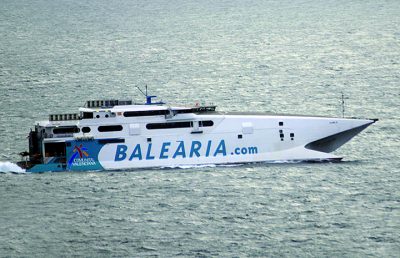
Baleària is employing the 4,112gt/1996 built Jaume II (above) this summer to connect Majorca (Alcudia) and Menorca (Ciutadella) with Barcelona.
Bay Ferries’ The Cat will resume service between Portland, Maine and Yarmouth, Nova Scotia in June 2018 after the company and the Government of Nova Scotia agreed to pay for upgrades to the ferry terminal in Portland to meet US Customs & Border Protection Agency demands.
Brittany Ferries’ new 27,414gt/2007 built Connemara arrived at Santander on 23rd April for her refit and to receive her Brittany Ferries branding on a white livery. She completed her maiden voyage overnight from Cork on 8th May but was diverted from Roscoff, to Brest to avoid a Union protest at the original destination.
CalMac’s new Brodick Ferry Terminal was officially opened by Cabinet Secretary for Finance and the Constitution Derek Mackay on 12th April following a £30 million infrastructure upgrade project undertaken by CMAL, which has transformed the harbour area. The project has created a flagship harbour for the Isle of Arran and provides 21st century facilities that will boost the local economy.
Caledonian Maritime Assets Ltd. (CMAL) has reached an agreement to purchase three passenger ferries serving the Northern Isles. The company has bought the units outright with loan funding from the Scottish Government. The vessels in question are the 8,780gt/2002 built Hamnavoe and 11,720gt/2002 built Hrossey and Hjaltland, which have previously been leased from the Royal Bank of Scotland. Additionally, the company secured an 18-month extension to the current Northern Isles Ferry Services contract to allow further progress to be made with the ongoing review of procurement policy for future ferry operating contracts. Serco NorthLink Ferries will continue to operate the services until 31st October 2019 under the extended contract.
CLdN’s new Ro-Ro giant 74,273gt/2017 built Celine was christened in Dublin Port on 20th April. The ship operates with a Russian crew of 27 between Dublin and Zeebrugge and Dublin-Zeebrugge-Killingholme. The 234m long, 8.16m draught and 19 knot ship is powered by a 21,060kW Hyundai B&W main engine. The Celine can carry 503 trailers or 3,795 cars.
Corsica Linea has confirmed the 5-year charter of the 30,144gt/1999 built Euroferry Corfu (ex-Finneagle), to be renamed Vizzavona (a village near the Monte d’Oro between Ajaccio and Corte). The ship will operate Marseille-Sardinia-Tunisia-Algeria schedule from mid-June.
Destination Gotland’s new 32,000gt Visborg, currently under construction in China, is set to be delivered in July after a delay caused by moving the ship to a new shipyard location outside of Guangzhou.
Finnlines announced on 3rd May that it has signed an order for three Ro-Ro vessels from the Chinese Jinling shipyard. The delivery of these vessels is expected as from 2020-2021 and the total investment will be over €200 million. The 17,400dwt vessels are 238m long and will have a cargo capacity of 5,800 lanemetres plus 5,600m2 of car decks and a capacity of around 300 TEU on the weather deck.
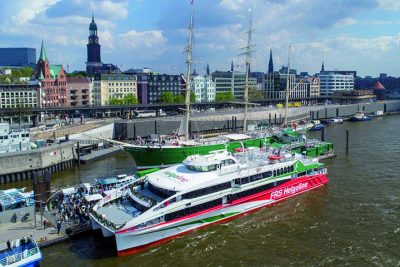
FRS Helgoline’s new catamaran arrived at her new home of Hamburg on 24th April after her delivery voyage from the Philippines (above). The vessel was officially named Halunder Jet on 27th April.


Hovertravel’s 1990 built AP1-88 hovercraft Freedom 90 (above) was retired from the operational fleet on 30th April after just under 28 years of sterling service. Sister AP1-88 Island Express had been stored at Griffon Hoverwork’s Woolston Yard a few weeks earlier so this brings to an end the reign of AP1-88s on the Solent. The Ryde-Southsea service is now left in the hands of the two 2016 built 12000TD hovercraft, Solent Flyer and Island Flyer.
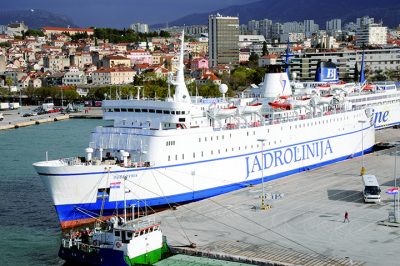
Montenegro Lines and Jadrolinija have announced that the Bari-Bar service will run again in 2018, 22nd May-28th November. The 9,795gt/1979 built Dubrovnik (above), the former Brittany Ferries’ Duchess Anne, will make 1-2 trips per week between the two ports plus up to four round trips between Dubrovnik and Bari.
Red Funnel announced on 2nd May that it is trialling the use of Green D+ fossil-free fuel on its Ro-Pax fleet of ships which operate between Southampton and East Cowes. The cross-Solent ferry company has teamed up with Green Biofuels, to trial Green D+ biofuel with varying amounts of low-sulphur Marine Gas Oil, to power the main engines and on-board generators. The aim is to significantly reduce greenhouse gas emissions. Green D+ fuel is formulated by Green Biofuels using a patented performance additive to HVO (Hydrotreated Vegetable Oil) renewable diesel. The HVO is produced by Neste in Europe from a variety of waste and residue materials (i.e. used cooking oil and waste fats from the food processing industry) as well as plant oils (such as Palm Oil and Rapeseed Oil). The waste oil is recycled back into fuel, eliminating the dangers of inefficient and often dangerous disposal or its re-use in the food chain.
Samskip incorporated Rotterdam into Nor Lines’ flexible LNG-powered service network via a weekly call of the multipurpose liner service as from 1st June, connecting to Western, Mid and Northern Norway. The service is provided by Nor Lines’ state of the art, 9,132gt/2015 built LNG fuelled vessels Kvitnos and Kvitbjorn, which each offer 550 lanemetres of Ro-Ro capacity, 122 TEU as container space, 1,500 tons of reefer space in the lower holds and are equipped with a heavy lift crane. The ships sail in a 14-day loop, connecting Rotterdam and Eemshaven with Hammerfest in the far north of Norway plus Sandnes/Tananger, Bergen, Trondheim, Ålesund, Bodo and Tromso.
Stena Line’s Fishguard Harbour terminal could close for three months to allow major re-development works to be carried out. Ferry services look set to be suspended 1st February-30th April for the construction of a new hydraulic linkspan and other associated works. Easter trade on the Rosslare service will therefore be decimated.
TT-Line Company Pty Ltd. and Flensburger Schiffbau-Gesellschaft (FSG) have signed a contract for the design and construction of two new LNG passenger ferries. The order has a total volume of approximately €438 million for both vessels. The two new ships will be 212m long and can carry 1,800 passengers and up to 600 passenger vehicles. They are powered by LNG and both will be completed in 2021 to begin operations on the Bass Strait.

Viking Line’s 35,492gt/1992 built Gabriella (above) returned to service on 29th April after a two week dry docking at the Naantali shipyard. The refit provided the opportunity to initiate the renewal of the ship’s restaurant concepts. The ship’s Food Garden restaurant became the À la carte & Seafood Bar restaurant, and the restaurant Bistrotek transformed into a pop-up theme restaurant. Both venues were officially launched on 1st June.
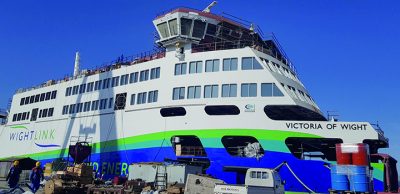
Wightlink’s new flagship Victoria of Wight (above) had been in the water exactly three months on 7th May since her launch at the Cemre Shipyard in Yalova, Turkey. Fitting out is well underway with the installation of her four Wartsila engines, batteries and generators for the hybrid energy propulsion system and Voith propellers plus glazing the public areas etc. On board, there will be both a Costa coffee shop and a Wight Taste outlet selling Isle of Wight sourced food and drink. Sea trials were due to start in the Sea of Marmara later in May. The Victoria of Wight is 90m long and 19.4m wide, slightly larger than the St. Clare. The ship has an unladen tonnage of 2,550t, can accommodate 178 cars and offers spacious lounges (500m2) and 550m2 of outside passenger decks. The ship has been fitted with more than 146km of cable, weighing 76 tonnes plus has received 30,000 litres of paint.
Wyker Dampfschiffs-Reederei has taken delivery of the company’s latest double-ended ferry, the 3,250gt/2018 built Norderaue from Neptun Werft in Rostock, replacing the 1992 built Rungholt. The 76m vessel will operated between the islands of Foehr, Amrum and the German mainland. The Norderaue joins her sisters Schleswig Holstein (3,202gt/built 2011 by Neptun) and the 3,179gt/2010 built Uthlande (from Sietas in Hamburg). Her capacity is 1200 passengers and 350 lanemetres for vehicles. Depending on the route, the trip takes 1-2 hours across the scenic Wadden Sea which can be enjoyed from comfortable saloons and large sundecks.

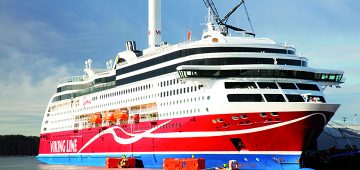



Comments
Sorry, comments are closed for this item